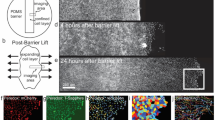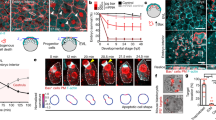Abstract
For an epithelium to provide a protective barrier, it must maintain homeostatic cell numbers by matching the number of dividing cells with the number of dying cells. Although compensatory cell division can be triggered by dying cells1,2,3, it is unknown how cell death might relieve overcrowding due to proliferation. When we trigger apoptosis in epithelia, dying cells are extruded to preserve a functional barrier4. Extrusion occurs by cells destined to die signalling to surrounding epithelial cells to contract an actomyosin ring that squeezes the dying cell out4,5,6. However, it is not clear what drives cell death during normal homeostasis. Here we show in human, canine and zebrafish cells that overcrowding due to proliferation and migration induces extrusion of live cells to control epithelial cell numbers. Extrusion of live cells occurs at sites where the highest crowding occurs in vivo and can be induced by experimentally overcrowding monolayers in vitro. Like apoptotic cell extrusion, live cell extrusion resulting from overcrowding also requires sphingosine 1-phosphate signalling and Rho-kinase-dependent myosin contraction, but is distinguished by signalling through stretch-activated channels. Moreover, disruption of a stretch-activated channel, Piezo1, in zebrafish prevents extrusion and leads to the formation of epithelial cell masses. Our findings reveal that during homeostatic turnover, growth and division of epithelial cells on a confined substratum cause overcrowding that leads to their extrusion and consequent death owing to the loss of survival factors. These results suggest that live cell extrusion could be a tumour-suppressive mechanism that prevents the accumulation of excess epithelial cells.
This is a preview of subscription content, access via your institution
Access options
Subscribe to this journal
Receive 51 print issues and online access
$199.00 per year
only $3.90 per issue
Buy this article
- Purchase on Springer Link
- Instant access to full article PDF
Prices may be subject to local taxes which are calculated during checkout




Similar content being viewed by others
References
Fan, Y. & Bergmann, A. Apoptosis-induced compensatory proliferation. The Cell is dead. Long live the Cell! Trends Cell Biol 18, 467–473 (2008)
Fan, Y. & Bergmann, A. Distinct mechanisms of apoptosis-induced compensatory proliferation in proliferating and differentiating tissues in the Drosophila eye. Dev. Cell 14, 399–410 (2008)
Ryoo, H. D., Gorenc, T. & Steller, H. Apoptotic cells can induce compensatory cell proliferation through the JNK and the Wingless signaling pathways. Dev. Cell 7, 491–501 (2004)
Rosenblatt, J., Raff, M. C. & Cramer, L. P. An epithelial cell destined for apoptosis signals its neighbors to extrude it by an actin- and myosin-dependent mechanism. Curr. Biol. 11, 1847–1857 (2001)
Gu, Y., Forostyan, T., Sabbadini, R. & Rosenblatt, J. Epithelial cell extrusion requires the sphingosine-1-phosphate receptor 2 pathway. J. Cell Biol. 193, 667–676 (2011)
Slattum, G., McGee, K. M. & Rosenblatt, J. P115 RhoGEF and microtubules decide the direction apoptotic cells extrude from an epithelium. J. Cell Biol. 186, 693–702 (2009)
Monks, J., Smith-Steinhart, C., Kruk, E. R., Fadok, V. A. & Henson, P. M. Epithelial cells remove apoptotic epithelial cells during post-lactation involution of the mouse mammary gland. Biol. Reprod. 78, 586–594 (2008)
Riedl, J. et al. Lifeact: a versatile marker to visualize F-actin. Nature Methods 5, 605–607 (2008)
Frisch, S. M. & Francis, H. Disruption of epithelial cell-matrix interactions induces apoptosis. J. Cell Biol. 124, 619–626 (1994)
Gilmore, A. P. Anoikis. Cell Death Differ. 12 (suppl. 2), 1473–1477 (2005)
Reddig, P. J. & Juliano, R. L. Clinging to life: cell to matrix adhesion and cell survival. Cancer Metastasis Rev. 24, 425–439 (2005)
Andrade, D. & Rosenblatt, J. Apoptotic regulation of epithelial cellular extrusion. Apoptosis 16, 491–501 (2011)
Tournier, C. et al. Requirement of JNK for stress-induced activation of the cytochrome c-mediated death pathway. Science 288, 870–874 (2000)
Coste, B. et al. Piezo1 and Piezo2 are essential components of distinct mechanically activated cation channels. Science 330, 55–60 (2010)
Olsen, S. M., Stover, J. D. & Nagatomi, J. Examining the role of mechanosensitive ion channels in pressure mechanotransduction in rat bladder urothelial cells. Ann. Biomed. Eng. 39, 688–697 (2011)
Bhattacharya, M. R. et al. Radial stretch reveals distinct populations of mechanosensitive mammalian somatosensory neurons. Proc. Natl Acad. Sci. USA 105, 20015–20020 (2008)
Yang, X. C. & Sachs, F. Block of stretch-activated ion channels in Xenopus oocytes by gadolinium and calcium ions. Science 243, 1068–1071 (1989)
Haas, P. & Gilmour, D. Chemokine signaling mediates self-organizing tissue migration in the zebrafish lateral line. Dev. Cell 10, 673–680 (2006)
Tallafuss, A. et al. Turning gene function ON and OFF using sense- and antisense-photo-morpholinos in zebrafish. Development (in the press)
Holgate, S. T. The airway epithelium is central to the pathogenesis of asthma. Allergol. Int. 57, 1–10 (2008)
Knight, D. A. & Holgate, S. T. The airway epithelium: structural and functional properties in health and disease. Respirology 8, 432–446 (2003)
Swindle, E. J., Collins, J. E. & Davies, D. E. Breakdown in epithelial barrier function in patients with asthma: identification of novel therapeutic approaches. J. Allergy Clin. Immunol. 124, 23–34,–quiz 35–36 (2009)
Shraiman, B. I. Mechanical feedback as a possible regulator of tissue growth. Proc. Natl Acad. Sci. USA 102, 3318–3323 (2005)
Yoshigi, M., Clark, E. B. & Yost, H. J. Quantification of stretch-induced cytoskeletal remodeling in vascular endothelial cells by image processing. Cytometry A 55A, 109–118 (2003)
Yoshigi, M., Hoffman, L. M., Jensen, C. C., Yost, H. J. & Beckerle, M. C. Mechanical force mobilizes zyxin from focal adhesions to actin filaments and regulates cytoskeletal reinforcement. J. Cell Biol. 171, 209–215 (2005)
Kimmel, C. B., Ballard, W. W., Kimmel, S. R., Ullmann, B. & Schilling, T. F. Stages of embryonic development of the zebrafish. Dev. Dyn. 203, 253–310 (1995)
Davison, J. M. et al. Transactivation from Gal4-VP16 transgenic insertions for tissue-specific cell labelling and ablation in zebrafish. Dev. Biol. 304, 811–824 (2007)
Acknowledgements
We thank B. Welm, M. Redd and K. Ullman for valuable input on our manuscript and T. Marshall and D. Andrade for Lifeact- and BCL2-expressing MDCK lines. The custom-designed cell culture device was made with the support of National Institute of Biomedical Imaging and Bioengineering Grant EB-4443 to M.Y. (patent pending). This work was supported by a NIH-NIGMS NIH Director’s New Innovator Award 1 DP2 OD002056-01 and a Laura and Arthur Colwin Endowed Marine Biology Laboratories Summer Research Fellowship Fund to J.R., and a P30 CA042014 awarded to The Huntsman Cancer Institute for core facilities. An NIH Multidisciplinary Cancer Training Program Grant 5T32 CA03247-8 and American Cancer Society Salt Lake City Postdoctoral Fellowship (120464-PF-11-095-01 CSM) supported G.T.E., the University of Utah Undergraduate Research Opportunities Program Parent Fund Assistantship supported P.D.L., and an NIH R01 Grant MH092256 supported H.O. and C.B.C.
Author information
Authors and Affiliations
Contributions
G.T.E. and P.D.L. both contributed to the study design and performed all the experiments. M.Y. designed the stretching apparatus and consulted in the study design. J.R. found preliminary results of live cell extrusion in vivo and contributed to the design of the study. G.T.E., J.R. and P.D.L. analysed the data and wrote the paper. P.A.M. designed the photo-cleavable morpholinos, and H.O. and C.-B.C. provided zebrafish with epidermal Kaede expression. All authors discussed the results and commented on the manuscript.
Corresponding author
Ethics declarations
Competing interests
The authors declare no competing financial interests.
Supplementary information
Supplementary Information
This file contains Supplementary Figures 1-11. (PDF 1169 kb)
Supplementary Movie 1
This movie shows MDCK cells within a monolayer expressing Lifeact-GFP at 1 hour after overcrowding and illustrates extrusions occurring within the monolayer due to contracting actin rings. Images were captured every 2 minutes over the course of 30 minutes. (MOV 1349 kb)
Supplementary Movie 2
This movie shows a lateral view of a developing Tg(cldnb:lynGFP) zebrafish embryo at 51-54 hours post-fertilization, every 2 minutes over the course of 3 hours. Epithelial cells migrate towards the edge of the tail, where they eventually extrude from the tissue. (MOV 3204 kb)
Supplementary Movie 3
This movie shows a rotating confocal projection of a 10 mM Gd3+-treated zebrafish larvae immunostained with actin (red) and DNA (turquoise) (shown in Figure 4g) and highlights the cell masses protruding from the epidermis on either side of the fin. (MOV 1860 kb)
Supplementary Movie 4
This movie shows a lateral view, anterior to the left, of 60 hpf Tg(cldnb:lynGFP) zebrafish treated with 10 mM Gd3+ shows the epidermal masses arise from failed extrusion at the edge of the tail fin, where two areas of tissue converge. Cell migration occurs every 2 minutes over the course of 3 hours. (MOV 1160 kb)
Rights and permissions
About this article
Cite this article
Eisenhoffer, G., Loftus, P., Yoshigi, M. et al. Crowding induces live cell extrusion to maintain homeostatic cell numbers in epithelia. Nature 484, 546–549 (2012). https://doi.org/10.1038/nature10999
Received:
Accepted:
Published:
Issue Date:
DOI: https://doi.org/10.1038/nature10999
This article is cited by
-
Homeostatic regulation of renewing tissue cell populations via crowding control: stability, robustness and quasi-dedifferentiation
Journal of Mathematical Biology (2024)
-
Slik maintains tissue homeostasis by preventing JNK-mediated apoptosis
Cell Division (2023)
-
The cellular states and fates of shed intestinal cells
Nature Metabolism (2023)
-
Mechanical stress driven by rigidity sensing governs epithelial stability
Nature Physics (2023)
-
Highly specific and non-invasive imaging of Piezo1-dependent activity across scales using GenEPi
Nature Communications (2023)
Comments
By submitting a comment you agree to abide by our Terms and Community Guidelines. If you find something abusive or that does not comply with our terms or guidelines please flag it as inappropriate.



